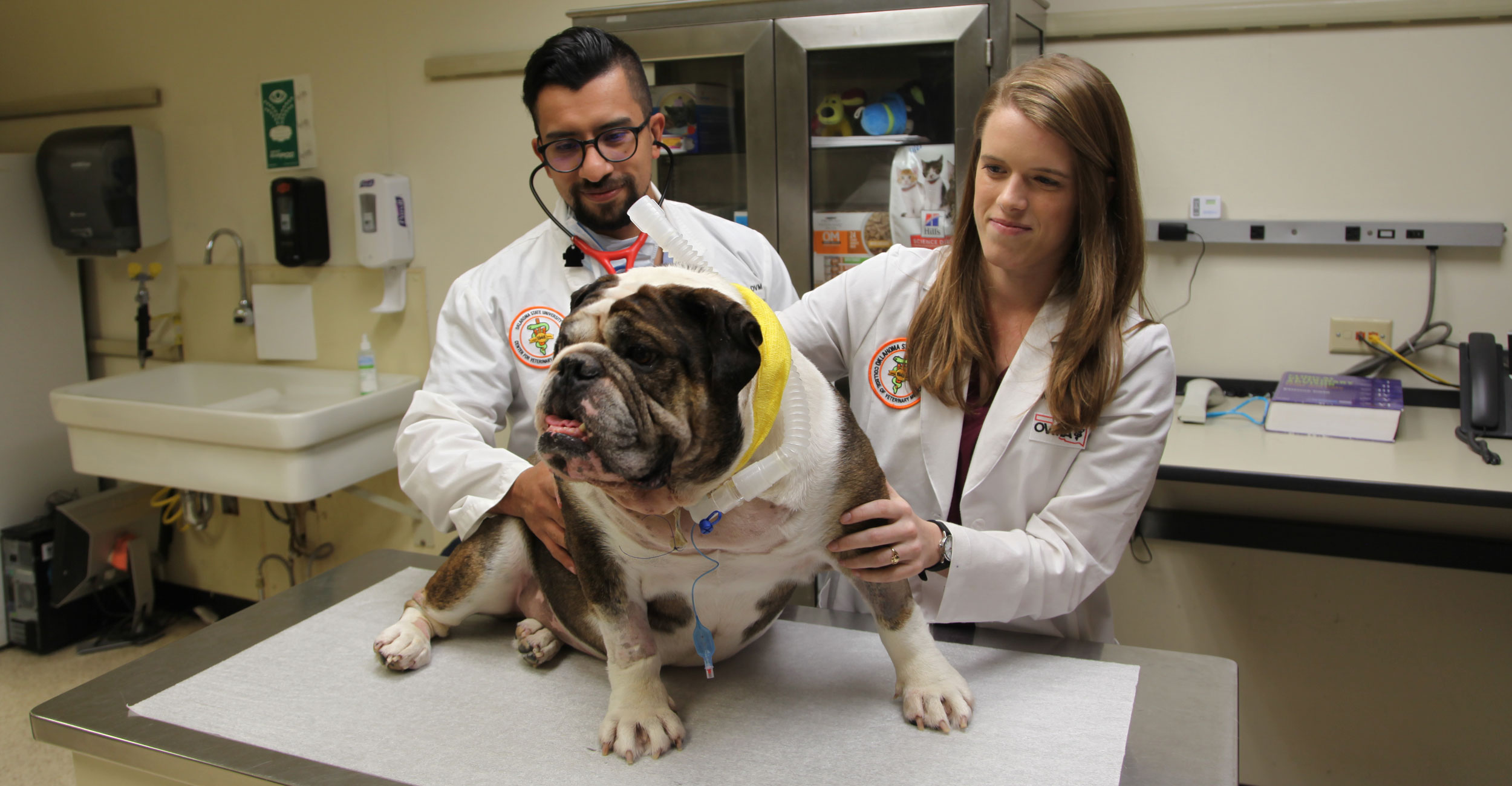
'Snorkel' Helps Bulldog Breathe
Monday, November 8, 2021
Media Contact: Kaylie Wehr | College of Veterinary Medicine | 405-744-6728 | kaylie.wehr@okstate.edu
Doctors at Oklahoma State University’s College of Veterinary Medicine had to get creative in helping a recent patient breathe following surgery to address an obstruction of his upper airway.
In October, Tater — a 5-year-old male English Bulldog — came to OSU’s Boren Veterinary Medical Hospital for evaluation of a breathing problem. Drs. Erik Clary, associate professor of small animal surgery, and Rodrigo Roca, senior surgery resident, were on the case.
“Tater’s owners noticed that while he’s had noisy breathing most of his life, in recent weeks his breathing also became labored and even caused him to turn blue during a wellness exam at the veterinarian’s office,” Clary said.
The surgery team suspected Tater had progression of an upper airway problem known as Brachycephalic Airway Syndrome (BAS) that affects many dogs with a compact facial conformation, such as bulldogs. He was quickly admitted for diagnosis and treatment.
“Our first priority was to get Tater set up in an oxygen unit in our Intensive Care suite where he could breathe easier while we charted out a plan,” Clary said.
“The first night we monitored him, and he did OK, but by the next morning he was having a hard time breathing after going outside to use the bathroom,” Roca said.
Tater was then put under sedation to have the back of his throat examined.
“The BAS condition may feature a number of abnormalities,” Clary said. “For Tater, these included an excessively long soft palate and protrusion of soft tissue in the front part of the opening to his windpipe (trachea). He was basically trying to breathe through a small straw and that had him pitched on the edge of a life-threatening crisis.”
With severe BAS, surgery is necessary to remove the obstruction.
“Tater ended up having to have emergency surgery that morning because he was having such a hard time breathing,” Roca said. “His palate was trimmed back and the protruding tissue was removed.”
His initial recovery went well, but 36 hours out from surgery, he began to experience breathing difficulties again.
“Chest x-rays and an airway exam revealed Tater had developed pneumonia and swelling of the tissues in the back of the throat, severe enough to impair ventilation,” Clary said.
To help Tater breathe adequately while allowing the swelling and lung infection to clear, Roca performed a tracheostomy.
“With a tracheostomy, an opening is made in the trachea on the underside of the neck and a breathing tube is inserted, bypassing the throat and nasal/oral passages,” Clary said. “We had to improvise because we knew Tater sleeps on his belly and such a position would force the opening of the tracheostomy tube downward into his bedding.”
Thinking on his feet as surgeons often must do, Roca fashioned a snorkel from some sterile anesthetic tubing and connected it to the tracheostomy tube. The snorkel succeeded in helping Tater breathe through his tracheostomy tube.
After Tater’s throat swelling and pneumonia resolved, the breathing tube and snorkel were removed. Freed of the apparatus and no longer “breathing through a small straw,” he was discharged from the hospital and has since done very well at home. His owner happily reports that he makes so little noise now when he sleeps that they nudge him every now and then just to assure themselves that he is alive.
“Tater was a joy to serve,” Clary said. “And it was totally a team effort with many CVM colleagues contributing to his care, including a very innovative and hard-working senior resident. Dr. Roca and I, and the whole team, are very pleased to know that Tater is at home breathing comfortably and bringing more joy to his family.”
